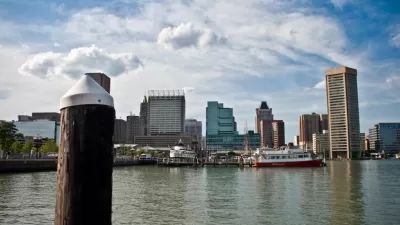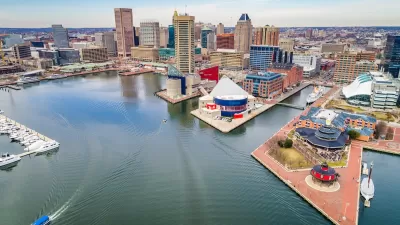The National Aquarium wants to recreate the tidal marshes that once lined the city's waterfront.

Baltimore's Inner Harbor "was once lined with tidal salt marshes, only a few feet deep and teeming with aquatic life," writes Elizabeth Shwe. But as the city industrialized, those marshes were dredged to make room for deepwater shipping ports. "Now the National Aquarium is trying to recreate those rich tidal marshes of yore by building an oasis of floating wetlands at the aquarium’s campus off Pratt Street."
"Floating wetlands can bring natural habitats back to the harbor, such as a nursery for hatching fish and a safe shallow place for blue crabs to shed their shells," as well as improve water quality and provide educational opportunities for local residents. Jack Cover, general curator of living exhibits at the National Aquarium, "has been maintaining a 400-square-foot floating wetland prototype for four years, testing the durability of materials in the Harbor and gathering information on what animals will inhabit this habitat to prepare for the aquarium’s larger project." He says "[f]loating wetlands are also examples of how low-tech green infrastructure can be added to a waterfront city to help clean air and water."
Cover hopes "[l]earning more about the harbor could motivate people to make small changes in their lives such as planting more trees to expand green infrastructure or advocating for better environmental legislation."
FULL STORY: Floating Wetlands Planned for Inner Harbor to Revive Urban Ecosystems, Clean Water

Alabama: Trump Terminates Settlements for Black Communities Harmed By Raw Sewage
Trump deemed the landmark civil rights agreement “illegal DEI and environmental justice policy.”

Planetizen Federal Action Tracker
A weekly monitor of how Trump’s orders and actions are impacting planners and planning in America.

The 120 Year Old Tiny Home Villages That Sheltered San Francisco’s Earthquake Refugees
More than a century ago, San Francisco mobilized to house thousands of residents displaced by the 1906 earthquake. Could their strategy offer a model for the present?

In Both Crashes and Crime, Public Transportation is Far Safer than Driving
Contrary to popular assumptions, public transportation has far lower crash and crime rates than automobile travel. For safer communities, improve and encourage transit travel.

Report: Zoning Reforms Should Complement Nashville’s Ambitious Transit Plan
Without reform, restrictive zoning codes will limit the impact of the city’s planned transit expansion and could exclude some of the residents who depend on transit the most.

Judge Orders Release of Frozen IRA, IIJA Funding
The decision is a victory for environmental groups who charged that freezing funds for critical infrastructure and disaster response programs caused “real and irreparable harm” to communities.
Urban Design for Planners 1: Software Tools
This six-course series explores essential urban design concepts using open source software and equips planners with the tools they need to participate fully in the urban design process.
Planning for Universal Design
Learn the tools for implementing Universal Design in planning regulations.
Clanton & Associates, Inc.
Jessamine County Fiscal Court
Institute for Housing and Urban Development Studies (IHS)
City of Grandview
Harvard GSD Executive Education
Toledo-Lucas County Plan Commissions
Salt Lake City
NYU Wagner Graduate School of Public Service




























